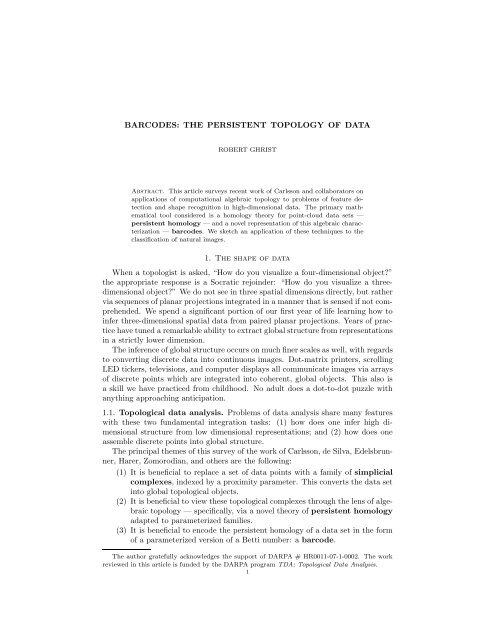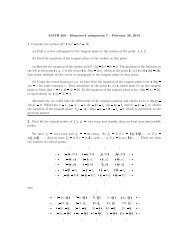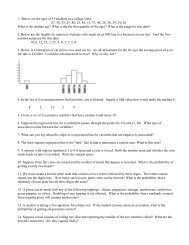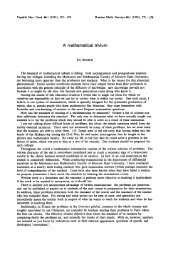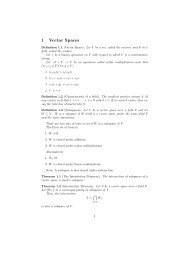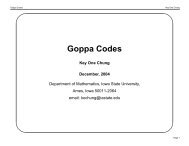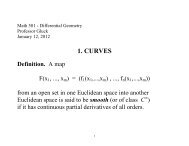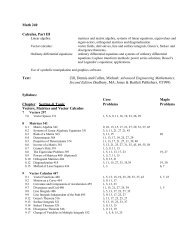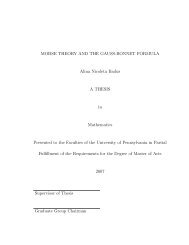Barcodes - Department of Mathematics
Barcodes - Department of Mathematics
Barcodes - Department of Mathematics
Create successful ePaper yourself
Turn your PDF publications into a flip-book with our unique Google optimized e-Paper software.
BARCODES: THE PERSISTENT TOPOLOGY OF DATA<br />
ROBERT GHRIST<br />
Abstract. This article surveys recent work <strong>of</strong> Carlsson and collaborators on<br />
applications <strong>of</strong> computational algebraic topology to problems <strong>of</strong> feature detection<br />
and shape recognition in high-dimensional data. The primary mathematical<br />
tool considered is a homology theory for point-cloud data sets —<br />
persistent homology — and a novel representation <strong>of</strong> this algebraic characterization<br />
— barcodes. We sketch an application <strong>of</strong> these techniques to the<br />
classification <strong>of</strong> natural images.<br />
1. The shape <strong>of</strong> data<br />
When a topologist is asked, “How do you visualize a four-dimensional object?”<br />
the appropriate response is a Socratic rejoinder: “How do you visualize a threedimensional<br />
object?” We do not see in three spatial dimensions directly, but rather<br />
via sequences <strong>of</strong> planar projections integrated in a manner that is sensed if not comprehended.<br />
We spend a significant portion <strong>of</strong> our first year <strong>of</strong> life learning how to<br />
infer three-dimensional spatial data from paired planar projections. Years <strong>of</strong> practice<br />
have tuned a remarkable ability to extract global structure from representations<br />
in a strictly lower dimension.<br />
The inference <strong>of</strong> global structure occurs on much finer scales as well, with regards<br />
to converting discrete data into continuous images. Dot-matrix printers, scrolling<br />
LED tickers, televisions, and computer displays all communicate images via arrays<br />
<strong>of</strong> discrete points which are integrated into coherent, global objects. This also is<br />
a skill we have practiced from childhood. No adult does a dot-to-dot puzzle with<br />
anything approaching anticipation.<br />
1.1. Topological data analysis. Problems <strong>of</strong> data analysis share many features<br />
with these two fundamental integration tasks: (1) how does one infer high dimensional<br />
structure from low dimensional representations; and (2) how does one<br />
assemble discrete points into global structure.<br />
The principal themes <strong>of</strong> this survey <strong>of</strong> the work <strong>of</strong> Carlsson, de Silva, Edelsbrunner,<br />
Harer, Zomorodian, and others are the following:<br />
(1) It is beneficial to replace a set <strong>of</strong> data points with a family <strong>of</strong> simplicial<br />
complexes, indexed by a proximity parameter. This converts the data set<br />
into global topological objects.<br />
(2) It is beneficial to view these topological complexes through the lens <strong>of</strong> algebraic<br />
topology — specifically, via a novel theory <strong>of</strong> persistent homology<br />
adapted to parameterized families.<br />
(3) It is beneficial to encode the persistent homology <strong>of</strong> a data set in the form<br />
<strong>of</strong> a parameterized version <strong>of</strong> a Betti number: a barcode.<br />
The author gratefully acknowledges the support <strong>of</strong> DARPA # HR0011-07-1-0002. The work<br />
reviewed in this article is funded by the DARPA program TDA: Topological Data Analysis.<br />
1
2 ROBERT GHRIST<br />
This review will introduce these themes and survey an example <strong>of</strong> these techniques<br />
applied to a high-dimensional data set derived from natural images.<br />
1.2. Clouds <strong>of</strong> data. Very <strong>of</strong>ten, data is represented as an unordered sequence <strong>of</strong><br />
points in a Euclidean n-dimensional space E n . Data coming from an array <strong>of</strong> sensor<br />
readings in an engineering testbed, from questionnaire responses in a psychology<br />
experiment, or from population sizes in a complex ecosystem all reside in a space<br />
<strong>of</strong> potentially high dimension. The global ‘shape’ <strong>of</strong> the data may <strong>of</strong>ten provide<br />
important information about the underlying phenomena which the data represents.<br />
One type <strong>of</strong> data set for which global features are present and significant is the<br />
so-called point cloud data coming from physical objects in 3-d. Touch probes,<br />
point lasers, or line lasers sweep a suspended body and sample the surface, recording<br />
coordinates <strong>of</strong> anchor points on the surface <strong>of</strong> the body. The cloud <strong>of</strong> such<br />
points can be quickly obtained and used in a computer representation <strong>of</strong> the object.<br />
A temporal version <strong>of</strong> this situation is to be found in motion-capture data,<br />
where geometric points are recorded as time series. In both <strong>of</strong> these settings, it is<br />
important to identify and recognize global features: where is the index finger, the<br />
keyhole, the fracture?<br />
Figure 1. Determining the global structure <strong>of</strong> a noisy point cloud<br />
is not difficult when the points are in E 2 , but for clouds in higher<br />
dimensions, a planar projection is not always easy to decipher.<br />
Following common usage, we denote by point cloud data any collection <strong>of</strong> points<br />
in E n , though the connotation is that <strong>of</strong> a (perhaps noisy) sample <strong>of</strong> points on a<br />
lower-dimensional subset. For point clouds residing in a low-dimensional ambient<br />
space, there are numerous approaches for inferring features based on planar projections:<br />
reconstruction techniques in the computer graphics and statistics literatures
PERSISTENT TOPOLOGY OF DATA 3<br />
are manifold. From a naive point <strong>of</strong> view, planar projections would appear to be<br />
<strong>of</strong> limited value in the context <strong>of</strong> data which is inherently high dimensional or<br />
sufficiently ‘twisted’ so as to preclude a faithful planar projection (Figure 1[right]).<br />
A more global and intrinsic approach to high-dimensional data clouds has recently<br />
appeared in the work <strong>of</strong> Carlsson and collaborators. This body <strong>of</strong> ideas applies<br />
tools from algebraic topology to extract coarse features from high-dimensional<br />
data sets. This survey is a brief overview <strong>of</strong> some <strong>of</strong> their work. As a result <strong>of</strong> our<br />
focus on techniques from algebraic topology, we neglect the large body <strong>of</strong> relevant<br />
work in nonlinear statistics (which is rarely topological) and in computer graphics<br />
(which is rarely high-dimensional).<br />
1.3. From clouds to complexes. The most obvious way to convert a collection<br />
<strong>of</strong> points {xα} in a metric space into a global object is to use the point cloud as the<br />
vertices <strong>of</strong> a combinatorial graph whose edges are determined by proximity (vertices<br />
within some specified distance ǫ). Such a graph, while capturing connectivity data,<br />
ignores a wealth <strong>of</strong> higher order features beyond clustering. These features can be<br />
accurately discerned by thinking <strong>of</strong> the graph as a scaffold for a higher-dimensional<br />
object. Specifically, one completes the graph to a simplicial complex — a space<br />
built from simple pieces (simplicies) identified combinatorially along faces. The<br />
choice <strong>of</strong> how to fill in the higher dimensional simplices <strong>of</strong> the proximity graph<br />
allows for different global representations. Two <strong>of</strong> the most natural methods for so<br />
doing are as follow:<br />
Definition 1.1. Given a collection <strong>of</strong> points {xα} in Euclidean space E n , the Čech<br />
complex1 , Cǫ, is the abstract simplicial complex whose k-simplices are determined<br />
by unordered (k + 1)-tuples <strong>of</strong> points {xα} k 0 whose closed ǫ/2-ball neighborhoods<br />
have a point <strong>of</strong> common intersection.<br />
Definition 1.2. Given a collection <strong>of</strong> points {xα} in Euclidean space E n , the Rips<br />
complex, 2 Rǫ, is the abstract simplicial complex whose k-simplices correspond to<br />
unordered (k + 1)-tuples <strong>of</strong> points {xα} k 0 which are pairwise within distance ǫ.<br />
The Čech theorem (or, equivalently, the “nerve theorem”) states that Cǫ has<br />
the homotopy type <strong>of</strong> the union <strong>of</strong> closed radius ǫ/2 balls about the point set<br />
{xα}. This means that C, though an abstract simplicial complex <strong>of</strong> potentially<br />
high dimension, behaves exactly like a subset <strong>of</strong> E n (see Figure 2). The Čech<br />
complex is a topologically faithful simplicial model for the topology <strong>of</strong> a point cloud<br />
fattened by balls. However, the Čech complex and various topologically equivalent<br />
subcomplexes (e.g., the alpha complex <strong>of</strong> [13]) are delicate objects to compute,<br />
relying on the precise distances between the nodes in E n .<br />
From a computational point <strong>of</strong> view, the Rips complex is less expensive that the<br />
corresponding Čech complex, even though the Rips complex has more simplices (in<br />
general). The reason is that the Rips complex is a flag complex: it is maximal<br />
among all simplicial complexes with the given 1-skeleton. Thus, the combinatorics<br />
<strong>of</strong> the 1-skeleton completely determines the complex, and the Rips complex can be<br />
stored as a graph and reconstituted instead <strong>of</strong> storing the entire boundary operator<br />
1 Also known as the nerve.<br />
2 A more appropriate name would be the Vietoris-Rips complex, in recognition <strong>of</strong> Vietoris’<br />
original use <strong>of</strong> these objects in the early days <strong>of</strong> homology theory [21]. For brevity we use the<br />
term “Rips complex.”
4 ROBERT GHRIST<br />
Cǫ<br />
ǫ<br />
Figure 2. A fixed set <strong>of</strong> points [upper left] can be completed to<br />
a a Čech complex Cǫ [lower left] or to a Rips complex Rǫ [lower<br />
right] based on a proximity parameter ǫ [upper right]. This Čech<br />
complex has the homotopy type <strong>of</strong> the ǫ/2 cover (S 1 ∨ S 1 ∨ S 1 ),<br />
while the Rips complex has a wholly different homotopy type (S 1 ∨<br />
S 2 ).<br />
needed for a Čech complex. This virtue — that coarse proximity data on pairs <strong>of</strong><br />
nodes determines the Rips complex — is not without cost. The penalty for this<br />
simplicity is that it is not immediately clear what is encoded in the homotopy type<br />
<strong>of</strong> R. In general, it is neither a subcomplex <strong>of</strong> E n nor does it necessarily behave<br />
like an n-dimensional space at all (Figure 2).<br />
1.4. Which ǫ? Converting a point cloud data set into a global complex (whether<br />
Rips, Čech, or other) requires a choice <strong>of</strong> parameter ǫ. For ǫ sufficiently small,<br />
the complex is a discrete set; for ǫ sufficiently large, the complex is a single highdimensional<br />
simplex. Is there an optimal choice for ǫ which best captures the<br />
topology <strong>of</strong> the data set? Consider the point cloud data set and a sequence <strong>of</strong> Rips<br />
complexes as illustrated in Figure 3. This point cloud is a sampling <strong>of</strong> points on<br />
a planar annulus. Can this be deduced? From the figure, it certainly appears as<br />
though an ideal choice <strong>of</strong> ǫ, if it exists, is rare: by the time ǫ is increased so as<br />
to remove small holes from within the annulus, the large hole distinguishing the<br />
annulus from the disk is filled in.<br />
2. Algebraic topology for data<br />
Algebraic topology <strong>of</strong>fers a mature set <strong>of</strong> tools for counting and collating holes<br />
and other topological features in spaces and maps between them. In the context <strong>of</strong><br />
Rǫ
PERSISTENT TOPOLOGY OF DATA 5<br />
Figure 3. A sequence <strong>of</strong> Rips complexes for a point cloud data<br />
set representing an annulus. Upon increasing ǫ, holes appear and<br />
disappear. Which holes are real and which are noise?<br />
high-dimensional data, algebraic topology works like a telescope, revealing objects<br />
and features not visible to the naked eye. In what follows, we concentrate on<br />
homology for its balance between ease <strong>of</strong> computation and topological resolution.<br />
We assume a rudimentary knowledge <strong>of</strong> homology, as is to be found in, say, Chapter<br />
2 <strong>of</strong> [15].<br />
Despite being both computable and insightful, the homology <strong>of</strong> a complex associated<br />
to a point cloud at a particular ǫ is insufficient: it is a mistake to ask which<br />
value <strong>of</strong> ǫ is optimal. Nor does it suffice to know a simple ‘count’ <strong>of</strong> the number and<br />
types <strong>of</strong> holes appearing at each parameter value ǫ. Betti numbers are not enough.<br />
One requires a means <strong>of</strong> declaring which holes are essential and which can be safely<br />
ignored. The standard topological constructs <strong>of</strong> homology and homotopy <strong>of</strong>fer no<br />
such slack in their strident rigidity: a hole is a hole no matter how fragile or fine.<br />
2.1. Persistence. Persistence, as introduced by Edelsbrunner, Letscher, and Zomorodian<br />
[12] and refined by Carlsson and Zomorodian [22], is a rigorous response to<br />
this problem. Given a parameterized family <strong>of</strong> spaces, those topological features<br />
which persist over a significant parameter range are to be considered as signal with<br />
short-lived features as noise. For a concrete example, assume that R = (Ri) N 1 is<br />
a sequence <strong>of</strong> Rips complexes associated to a fixed point cloud for an increasing<br />
sequence <strong>of</strong> parameter values (ǫi) N 1 . There are natural inclusion maps<br />
(2.1) R1<br />
ι<br />
֒→ R2<br />
ι<br />
֒→ · · ·<br />
ι<br />
֒→ RN−1<br />
ι<br />
֒→ RN
6 ROBERT GHRIST<br />
Instead <strong>of</strong> examining the homology <strong>of</strong> the individual terms Ri, one examines the<br />
homology <strong>of</strong> the iterated inclusions ι : H∗Ri → H∗Rj for all i < j. These maps<br />
reveal which features persist.<br />
As a simple example, persistence explains why Rips complexes are an acceptable<br />
approximation to Čech complexes. Although no single Rips complex is an especially<br />
faithful approximation to a single Čech complex, pairs <strong>of</strong> Rips complexes ‘squeeze’<br />
the appropriate Čech complex into a manageable hole.<br />
Lemma 2.1 (de Silva [10]). For any ǫ > 0, there is a chain <strong>of</strong> inclusion maps<br />
(2.2) Rǫ ֒→ C ǫ √ 2 ֒→ R ǫ √ 2 .<br />
(See [10] for the tight dimension-dependent bound smaller than √ 2.) This implies<br />
that any topological feature which persists under the inclusion Rǫ ֒→ Rǫ ′ is in<br />
fact a topological feature <strong>of</strong> the Čech complex Cǫ ′ when ǫ′ /ǫ ≥ √ 2. Moral: the<br />
homology <strong>of</strong> the inclusion ι∗ : H∗Rǫ → H∗Rǫ ′ reveals information that is not<br />
visible from H∗Rǫ and H∗Rǫ ′ unadorned. This is a foreshadowing <strong>of</strong> the broader<br />
idea <strong>of</strong> persistence arising in an arbitrary sequence <strong>of</strong> chain complexes.<br />
2.2. Persistent homology. One begins with a persistence complex: a sequence<br />
<strong>of</strong> chain complexes C = (C i ∗)i together with chain maps x : C i ∗ −→ C i+1<br />
∗ . (For<br />
notational simplicity, we do not index the chain maps x.) This is motivated by<br />
having a sequence <strong>of</strong> Rips or Čech complexes <strong>of</strong> increasing ǫ sampled at an increasing<br />
sequence <strong>of</strong> parameters {ǫi}. Since Rips or Čech complexes grow with ǫ, the chain<br />
maps x are naturally identified with inclusions.<br />
Definition 2.2. For i < j, the (i, j)-persistent homology <strong>of</strong> C, denoted H i→j<br />
∗ (C)<br />
is defined to be the image <strong>of</strong> the induced homomorphism x∗ : H∗(Ci ∗) → H∗(C j ∗).<br />
As an example, consider the filtration R = (Ri) <strong>of</strong> Rips complexes parameterized<br />
by proximities ǫi. Lemma 2.1 implies that if ǫj/ǫi ≥ √ 2, then H i→j<br />
k (R) �= 0 implies<br />
Hk(Cǫj) �= 0. Holes in the Čech complex are inferred by the persistent homology <strong>of</strong><br />
the Rips filtration.<br />
There is a good deal more algebraic structure in the interleaving <strong>of</strong> persistent<br />
homology groups, as explained in the work <strong>of</strong> Carlsson and Zomorodian. Fix a PID<br />
<strong>of</strong> coefficients R and place a graded R[x]-module structure on C with x acting as a<br />
shift map. That is, a unit monomial xn ∈ R[x] sends Ci ∗ to Ci+n ∗ via n applications<br />
<strong>of</strong> x. One assumes a finite-type condition that each Ci ∗ is finitely generated as an<br />
R[x]-module and that the sequence stabilizes in i (in the case <strong>of</strong> an infinite sequence<br />
<strong>of</strong> chain complexes).<br />
As the filtering <strong>of</strong> C is via chain maps x (cf. the setting <strong>of</strong> Rips complexes<br />
— simplices are added but never removed as ǫ increases), C is free as an R[x]module.<br />
The resulting homology H∗(C) retains the structure <strong>of</strong> an R[x]-module,<br />
but, unlike the chain module, is not necessarily free. Nor is it easily classified: the<br />
Artin-Rees theory from commutative algebra implies that the problem <strong>of</strong> classifying<br />
(finite-type) persistence modules such as H∗(C) is equivalent to classifying finitelygenerated<br />
non-negatively graded R[x]-modules. This is known to be very difficult<br />
in, say, Z[x].<br />
However, for coefficients in a field F, the classification <strong>of</strong> F[x]-modules follows<br />
from the Structure Theorem for PID’s, since the only graded ideals <strong>of</strong> F[x] are <strong>of</strong><br />
the form xn · F[x]. This implies the following:
PERSISTENT TOPOLOGY OF DATA 7<br />
Theorem 2.3 ([22]). For a finite persistence module C with field F coefficients,<br />
(2.3) H∗(C; F) ∼ = �<br />
x ti ⎛<br />
· F[x] ⊕ ⎝ �<br />
x rj · (F[x]/(x sj ⎞<br />
· F[x])) ⎠ .<br />
i<br />
This classification theorem has a natural interpretation. The free portions <strong>of</strong><br />
Equation (2.3) are in bijective correspondence with those homology generators<br />
which come into existence at parameter ti and which persist for all future parameter<br />
values. The torsional elements correspond to those homology generators which<br />
appear at parameter rj and disappear at parameter rj + sj. At the chain level,<br />
the Structure Theorem provides a birth-death pairing <strong>of</strong> generators <strong>of</strong> C (excepting<br />
those that persist to infinity).<br />
2.3. <strong>Barcodes</strong>. The parameter intervals arising from the basis for H∗(C; F) in<br />
Equation (2.3) inspire a visual snapshot <strong>of</strong> Hk(C; F) in the form <strong>of</strong> a barcode. A<br />
barcode is a graphical representation <strong>of</strong> Hk(C; F) as a collection <strong>of</strong> horizontal line<br />
segments in a plane whose horizontal axis corresponds to the parameter and whose<br />
vertical axis represents an (arbitrary) ordering <strong>of</strong> homology generators. Figure 4<br />
gives an example <strong>of</strong> barcode representations <strong>of</strong> the homology <strong>of</strong> the sampling <strong>of</strong><br />
points in an annulus from Figure 3 (illustrated in the case <strong>of</strong> a large number <strong>of</strong><br />
parameter values ǫi).<br />
H0<br />
H1<br />
H2<br />
Figure 4. [bottom] An example <strong>of</strong> the barcodes for H∗(R) in the<br />
example <strong>of</strong> Figure 3. [top] The rank <strong>of</strong> Hk(Rǫi) equals the number<br />
<strong>of</strong> intervals in the barcode for Hk(R) intersecting the (dashed) line<br />
ǫ = ǫi.<br />
j<br />
ǫ<br />
ǫ<br />
ǫ
8 ROBERT GHRIST<br />
Theorem 2.3 yields the fundamental characterization <strong>of</strong> barcodes:<br />
Theorem 2.4 ([22]). The rank <strong>of</strong> the persistent homology group H i→j<br />
k (C; F) is<br />
equal to the number <strong>of</strong> intervals in the barcode <strong>of</strong> Hk(C; F) spanning the parameter<br />
interval [i, j]. In particular, H∗(Ci ∗ ; F) is equal to the number <strong>of</strong> intervals which<br />
contain i.<br />
A barcode is best thought <strong>of</strong> as the persistence analogue <strong>of</strong> a Betti number.<br />
Recall that the k th Betti number <strong>of</strong> a complex, βk := rankHk, acts as a coarse<br />
numerical measure <strong>of</strong> Hk. As with βk, the barcode for Hk does not give any information<br />
about the finer structure <strong>of</strong> the homology, but merely a continuously<br />
parameterized rank. The genius <strong>of</strong> a barcode representation is the ability to qualitatively<br />
filter out topological noise and capture significant features. Indeed, as<br />
shown in [7], barcodes are stable in the presence <strong>of</strong> noise added to a [Morse] filtration.<br />
For example, in Figure 4, one sees (from a very coarse sampling) that the<br />
point cloud likely represents a connected object with one or two significant ‘holes’<br />
as measured by H1 and no significant higher homology.<br />
2.4. Computation. Most invariants in modern algebraic topology are not known<br />
for their ease <strong>of</strong> computation. Homology (in its simplest manifestations) appears exceptional<br />
in that the invariants arise as quotients <strong>of</strong> finite-dimensional vector spaces.<br />
In the context <strong>of</strong> applications, ‘finite’ may exceed reasonable bounds. There is no<br />
recourse to chanting “Homology is just linear algebra,” when faced with millions<br />
<strong>of</strong> simplices: one needs good algorithms. Fortunately, such exist with increasing<br />
scope and speed. The text [16] gives a comprehensive introduction to issues <strong>of</strong> and<br />
algorithms available for computing homology for realistic problems in application<br />
domains.<br />
More fortunate still, there is an excellent algorithm available for the computation<br />
<strong>of</strong> persistent homology groups and barcodes. The algorithm takes as its argument<br />
the filtered simplicial complex consisting <strong>of</strong> pairs (σi, τi), where σi is a simplex and<br />
τi is the time at which that simplex appears in the filtration. This algorithm first<br />
appears in the paper <strong>of</strong> Edelsbruner, Letscher, and Zomorodian [12] for simplicial<br />
subcomplexes <strong>of</strong> E 3 with Z2 coefficients and in that <strong>of</strong> Carlsson and Zomorodian<br />
[22] for general persistence complexes with field coefficients. The Matlab-based<br />
front end Plex by de Silva and Perry [11] incorporates the C++ persistent homology<br />
library <strong>of</strong> Kettner and Zomorodian with tools for inputting and manipulating<br />
simplicial complexes.<br />
It is worth noting that for chain filtrations arising from realistic data sets, the<br />
Rips complexes are <strong>of</strong> an unmanageable size. This necessitates efficient sampling<br />
or reduction <strong>of</strong> the complex with accurate topology. The witness complex <strong>of</strong><br />
Carlsson and de Silva [8, 9, 14] is one solution to this problem.<br />
2.5. Other directions. We note that the above is the briefest <strong>of</strong> treatments <strong>of</strong><br />
what quickly becomes a fascinating and very active sub-topic <strong>of</strong> computational<br />
topology. For those interested in the algebraic-topological aspects <strong>of</strong> the theory, we<br />
note the following recent developments:<br />
• There are other filtrations besides those associated to Čech or Rips complexes<br />
which are natural settings in which to contemplate persistence. The<br />
Morse filtration <strong>of</strong> a space X outfitted with f : X → R is a filtration
PERSISTENT TOPOLOGY OF DATA 9<br />
<strong>of</strong> X by excursion sets Xt = � f −1 ((−∞, t]) � . This (or a discretized version<br />
there<strong>of</strong>) is one commonly investigated setting [1, 7], as is filtration by<br />
means <strong>of</strong> curvature data [5].<br />
• Our discussion <strong>of</strong> persistence is couched in the setting <strong>of</strong> chain complexes<br />
indexed by a single parameter. There are strong motivations for wanting<br />
to treat multi-parameter families <strong>of</strong> complexes. However, there are fundamental<br />
algebraic difficult in constructing an analogous theory <strong>of</strong> persistence<br />
modules in this setting [24].<br />
• The computation <strong>of</strong> persistent relative homology is more subtle, since the<br />
ensuing parameterized chain complex C is no longer free as an F[x]-module.<br />
Bendich and Harer [in progress] have developed an algebraic construction<br />
for defining and computing persistent homology which has a particularly<br />
clean form in the setting <strong>of</strong> a Morse filtration. The analogue <strong>of</strong> Theorem<br />
2.3 provides a perfect pairing <strong>of</strong> Morse critical points.<br />
• The computation <strong>of</strong> persistent cohomology is not straightforward. As<br />
shown by de Silva [in progress], if you take the graded free F[x]-module<br />
chain complex C for the Morse filtration Xt <strong>of</strong> a space X, and dualize it<br />
as a graded free F[x]-module, i.e. if you construct Hom F[x](C, F[x]), then<br />
the homology <strong>of</strong> the resulting object as a graded F[x]-module is not the<br />
persistent cohomology <strong>of</strong> H ∗ (Xt), but rather that <strong>of</strong> the relative cohomology<br />
H ∗ (X, Xt). Computing absolute persistent cohomology necessitates a<br />
recourse to duality and the theory <strong>of</strong> Bendich-Harer above.<br />
3. Example: natural images<br />
One recent example <strong>of</strong> discovering topological structure in a high-dimensional<br />
data set comes from natural images. A collection <strong>of</strong> 4167 digital photographs <strong>of</strong><br />
random outdoor scenes was assembled in the late 1990s by van Hateren and van der<br />
Schaaf [20]. Mumford and others have posed several fascinating questions about<br />
the structure and potential universality <strong>of</strong> the statistics <strong>of</strong> this and similar sets <strong>of</strong><br />
images in the context <strong>of</strong> visual perception [17].<br />
3.1. “Round about the cauldron go”. Mumford, Lee, and Pederson [18] construct<br />
a data set by choosing at random 5000 three-pixel by three-pixel squares<br />
within each digital image and retaining the top 20% <strong>of</strong> these with respect to contrast.<br />
Each such square is a matrix <strong>of</strong> grey-scale intensities. The full data set<br />
consists <strong>of</strong> roughly 8,000,000 points in E 9 . By normalizing with respect to mean<br />
intensity and restricting attention to high-contrast images (those away from the<br />
origin), the data set is projected to a set <strong>of</strong> points M on a topological seven-sphere<br />
S 7 ⊂ E 8 . The details <strong>of</strong> this data set construction requires a choice <strong>of</strong> natural<br />
basis with respect to a particular norm for values <strong>of</strong> contrast patches. We refer the<br />
interested reader to [18] for details.<br />
3.2. “Hover through the fog”. So coarse a reduction <strong>of</strong> natural images (into<br />
three-by-three squares <strong>of</strong> grey-scale intensities) still leads to a point cloud <strong>of</strong> too<br />
high a dimension to visualize. Worse still, what structure is there is blurred and<br />
foggy: points appear at first to be distributed over the entire S 7 . A resort to density<br />
considerations is thus in order. The subject <strong>of</strong> density filtration is a well-trod area<br />
<strong>of</strong> statistics: see, e.g., [19].
10 ROBERT GHRIST<br />
A codensity function is used in [3] as follows. Fix a positive integer k > 0.<br />
For any point xα in the data set, define δk(xα) as the distance in E n from xα to<br />
k th nearest neighbor <strong>of</strong> xα in the data set. For a fixed value <strong>of</strong> k, δk is a positive<br />
distribution over the point cloud which measures the radius <strong>of</strong> the ball needed to<br />
enclose k neighbors. Values <strong>of</strong> δk are thus inversely related to the point cloud<br />
density. The larger a value <strong>of</strong> k used, the more averaging occurs among neighbors,<br />
blurring finer variations.<br />
The codensity is used to filter the data as follows. Denote by M[k, T] the subset<br />
<strong>of</strong> M in the upper T-percent <strong>of</strong> density as measured by δk. This is a two-parameter<br />
subset <strong>of</strong> the point cloud which, for reasonable values <strong>of</strong> k and T, represent an<br />
appropriate core.<br />
3.3. “When shall we three meet again?” The first interesting persistent homology<br />
computation on this data set occurs at the level <strong>of</strong> H1: to what extent are<br />
there ‘loops’ in the data set along which the cloud is concentrated?<br />
Taking a density threshold <strong>of</strong> T = 25 at neighbor parameter k = 300, with<br />
5000 points sampled at random from M[k, T], computing the barcode for the first<br />
homology H1 reveals a unique persistent generator [3]. See Figure 5. This indicates<br />
that the data set is diffused about a primary circle in the 7-sphere. The structure <strong>of</strong><br />
the barcode is robust with respect to the random sampling <strong>of</strong> the points in M[k, T].<br />
The goal <strong>of</strong> the homology computation is to discover a ‘hidden’ feature <strong>of</strong> a data<br />
set that is not discernable by clustering and connectivity alone. The simplest such<br />
feature would be, as indicated by the computation above, a primary circle about<br />
which the data is scattered. To what might this correspond? A close examination<br />
<strong>of</strong> the data point corresponding to the primary circle reveals a pattern <strong>of</strong> 3-by-3<br />
patches with one light region and one dark region separated by a linear transition.<br />
This nodal curve between light and dark is linear and appears in a circular family<br />
parameterized by the angle <strong>of</strong> the nodal line, as shown in Figure 5.<br />
As seen from the barcode, this generator is dominant at the threshold and codensity<br />
parameters chosen. An examination <strong>of</strong> the barcodes for the first homology<br />
group H1 <strong>of</strong> the data set filtered by codensity parameter k = 15 and threshold<br />
T = 25 reveals a different persistent first homology. The reduction in k leads to<br />
less averaging and more localized density sensitivity. The barcode <strong>of</strong> Figure 6 reveals<br />
that the persistent H1 <strong>of</strong> samples from M[k, T] has Betti number five. This<br />
does not connote the presence <strong>of</strong> five disjoint circles in the data set. Rather, by<br />
focusing on the generators and computing the barcode for H0, it is observed [3]<br />
that, besides the primary circle from the high-k H1 computation, there are two<br />
secondary circles which come into view at the lower density parameter.<br />
A close examination <strong>of</strong> these three circles reveals that each intersects the highk<br />
primary twice, yet the two secondary circles are disjoint. To what features in<br />
the data might these secondary circles correspond? As noted in [3], each secondary<br />
circle regulates images with three contrasting regions and interpolates between these<br />
states and the primary circle. The difference between the two secondary circles lies<br />
in their bias for horizontal and vertical stratification respectively. Figure 7 gives an<br />
interpretation <strong>of</strong> the meanings <strong>of</strong> the secondary circles.<br />
3.4. “Come like shadows, so depart!” What is the good <strong>of</strong> temporary topological<br />
features which emerge and dissolve as a function <strong>of</strong> the parameter ǫ? Does<br />
this lead to anything more than a heuristic for high-dimensional data sets that are
H1<br />
PERSISTENT TOPOLOGY OF DATA 11<br />
Figure 5. The H1 barcode for a random sampling <strong>of</strong> 5000 points<br />
<strong>of</strong> M[300, 25] yields a single generator. This generator indicates<br />
the nodal line between a single light and single dark patch as being<br />
the dominant feature <strong>of</strong> the primary circle in M.<br />
hard to visualize? While the work <strong>of</strong> Carlsson et al. is very recent, there are several<br />
applications <strong>of</strong> the topological approach to data analysis which argue in favor <strong>of</strong><br />
the proposition that homological structures in high dimensional data sets are <strong>of</strong><br />
scientific significance. Besides the Mumford data set reviewed here, persistent homology<br />
computations are being applied to geometric features <strong>of</strong> curves (e.g., optical<br />
character recognition) [5] and visual cortex data from primate experiments [4].<br />
With regards to the natural image data, it is instructive to think <strong>of</strong> the persistent<br />
homology <strong>of</strong> M as something akin to a Taylor approximation <strong>of</strong> the true space. The<br />
reduction <strong>of</strong> the full data set to an S 7 via projection is really a normalization to<br />
eliminate the zero-order (or “single patch”) terms in the data set. Following this<br />
analogy, the H1 primary generator fills the role <strong>of</strong> a next term in the expansion <strong>of</strong> the<br />
homotopy type <strong>of</strong> the data set, collating the nodal curve between two contrasting<br />
patches. The secondary circles, interpolating between single and dual nodal curves,<br />
act as higher-order terms in the expansion, in which horizontal and vertical biases<br />
arise.<br />
It is here that one gets deeper insight into the data set. Inspired by the meaning<br />
<strong>of</strong> the H1 barcodes <strong>of</strong> M, further investigation reveals what appears to be an<br />
intrinsic bias toward horizontal and vertical directions in the natural image data, as<br />
opposed to an artifact <strong>of</strong> the (right) angle at which the camera was held: [3] reports<br />
ǫ
12 ROBERT GHRIST<br />
H1<br />
Figure 6. The H1 barcode for M[15, 25] reveals five persistent<br />
generators. This implies the existence <strong>of</strong> two secondary circles,<br />
each <strong>of</strong> which intersects the third, large-k, primary circle twice.<br />
Figure 7. The secondary generators <strong>of</strong> H1 for M[15, 25] have<br />
an interpretation as regulating changes from dual-patch to triplepatch<br />
high contrast regions in horizontal and vertical biases respectively.<br />
that a repetition <strong>of</strong> the experiment with a camera held at a constant angle π/4 yields<br />
a data set whose secondary persistent H1 generators exhibits a bias towards true<br />
vertical and true horizontal: the axis <strong>of</strong> pixellation appears less relevant than the<br />
axis <strong>of</strong> gravity in natural image data.<br />
Is there any predictive power in the barcodes <strong>of</strong> the data set? Recent progress<br />
[3] demonstrates the insight that a persistent topology approach can yield. The<br />
barcodes for the second persistent homology H2 are more volatile with respect to<br />
ǫ
PERSISTENT TOPOLOGY OF DATA 13<br />
Figure 8. A Klein bottle (projected against its ‘barcode’) [left]<br />
is the non-orientable surface obtained by identifying opposite sides<br />
<strong>of</strong> a square as shown [right].<br />
changes in density and thresholding. This is not surprising: the lowest order terms<br />
in any expansion are always most easily perceived. However, there is indication<br />
<strong>of</strong> a persistent H2 generator (in Z2 coefficients) at certain settings <strong>of</strong> k and T.<br />
Combined with the basis <strong>of</strong> H1 generators, one obtains predictive insight to the<br />
structure <strong>of</strong> the space <strong>of</strong> high-contrast patches. At certain density thresholds, the<br />
H2 barcode, suitably trimmed with Occam’s razor, suggests a two-dimensional<br />
completion <strong>of</strong> the low-k persistent H1 basis into a Klein bottle (see Figure 8).<br />
Recall that this non-orientable surface can be realized as an identification space <strong>of</strong><br />
a square as in the figure. Figure 9 illustrates an embedding <strong>of</strong> this surface in the<br />
space <strong>of</strong> pixellated images. One notes that this is a natural completion <strong>of</strong> the lowdensity<br />
persistent H1 readings: the primary and secondary circles appear with the<br />
appropriate intersection properties. Fortunately, Z2 coefficients — most natural<br />
for computer implementation — is efficacious in detecting H2 for a Klein bottle.<br />
We emphasize that the point cloud data set M is vast, high-dimensional, and<br />
not at all concentrated sharply along distinct features. A cursory viewing <strong>of</strong> the<br />
data seems to indicate that the 7-sphere is filled densely with data points and that<br />
there is seemingly no coherent structure to be found. It is through the lens <strong>of</strong><br />
persistent homology — suitably tuned and aimed — that cogent features emerge<br />
and fade with changing parameters. These persistent generators, upon close examination,<br />
do correspond to meaningful structures in the data, inspiring a sensible<br />
parametrization <strong>of</strong> the global structure <strong>of</strong> the data set. This is the type <strong>of</strong> explanatory<br />
power that any exemplar <strong>of</strong> good applied mathematics provides to a scientific<br />
challenge.<br />
References<br />
[1] P. Bubenik and P. Kim, “A statistical approach to persistent homology,” preprint (2006).<br />
[2] E. Carlsson, G. Carlsson, and V. de Silva, “An algebraic topological method for feature<br />
identification,” Intl. J. Computational Geometry and Applications, 16:4 (2006), 291-314.<br />
[3] G. Carlsson, T. Ishkhanov, V. de Silva, and A. Zomorodian, “On the local behavior <strong>of</strong> spaces<br />
<strong>of</strong> natural images,” preprint, (2006).<br />
[4] G. Carlsson, T. Ishkhanov, F. Mémoli, D. Ringach, G. Sapiro, “Topological analysis <strong>of</strong> the<br />
responses <strong>of</strong> neurons in V1.,” in preparation (2006).
14 ROBERT GHRIST<br />
Figure 9. A Klein bottle embeds naturally in the parameter space<br />
as a completion <strong>of</strong> the 3-circle model. In the unfolded identification<br />
space shown, the primary circle wraps around the horizontal<br />
axis twice. The two secondary circles each wrap around the vertical<br />
axis once (note: the circle on the extreme left and right are<br />
glued together with opposite orientation). Each secondary circle<br />
intersects the primary circle twice.<br />
[5] G. Carlsson, A. Zomorodian, A. Collins, and L. Guibas, “Persistence barcodes for shapes,”<br />
Intl. J. Shape Modeling, 11 (2005), 149-187.<br />
[6] F. Chazal and A. Lieutier, “Weak feature size and persistent homology: computing homology<br />
<strong>of</strong> solids in R n from noisy data samples,” in Proc. 21st Sympos. Comput. Geom. (2005).<br />
[7] D. Cohen-Steiner, H. Edelsbrunner and J. Harer, “Stability <strong>of</strong> persistence diagrams,” in Proc.<br />
21st Sympos. Comput. Geom. (2005), 263–271.<br />
[8] V. de Silva, “A weak definition <strong>of</strong> Delaunay triangulation,” preprint (2003).<br />
[9] V. de Silva and G. Carlsson. “Topological estimation using witness complexes,” in SPBG04<br />
Symposium on Point-Based Graphics (2004), 157-166.<br />
[10] V. de Silva and R. Ghrist, “Coverage in sensor networks via persistent homology,” to appear,<br />
Alg. & Geom. Topology (2006).<br />
[11] V. de Silva and P. Perry, PLEX home page, http://math.stanford.edu/comptop/programs/plex/
PERSISTENT TOPOLOGY OF DATA 15<br />
[12] H. Edelsbrunner, D. Letscher, and A. Zomorodian, “Topological persistence and simplification,”<br />
Discrete Comput. Geom., 28:4 (2002), 511-533.<br />
[13] H. Edelsbrunner and E.P. Mücke, “Three-dimensional alpha shapes,” ACM Transactions on<br />
Graphics, 13:1, (1994), 43-72.<br />
[14] L. Guibas and S. Oudot, “Reconstruction using witness complexes,” in Proc. 18th ACM-<br />
SIAM Sympos. on Discrete Algorithms, (2007).<br />
[15] A. Hatcher, Algebraic Topology, Cambridge University Press, (2002).<br />
[16] T. Kaczynski, K. Mischaikow, and M. Mrozek, Computational Homology, Applied Mathematical<br />
Sciences 157, Springer-Verlag, (2004).<br />
[17] D. Mumford, “Pattern Theory: the <strong>Mathematics</strong> <strong>of</strong> Perception,” Proc. Intl. Congress <strong>of</strong><br />
Mathematicians, Vol. III (2002), 1–21.<br />
[18] D. Mumford, A. Lee, and K. Pedersen, “The nonlinear statistics <strong>of</strong> high-contrast patches in<br />
natural images,” Intl. J. Computer Vision, Vol. 54 (2003), 83–103.<br />
[19] B. Silverman, Density Estimation for Statistics and Data Analysis. Chapman & Hall/CRC<br />
(1986).<br />
[20] J. van Hateren and A. van der Schaff, “Independent Component Filters <strong>of</strong> Natural Images<br />
Compared with Simple Cells in Primary Visual Cortex”, Proc. R. Soc. London, vol B 265<br />
(1998), 359–366.<br />
[21] L. Vietoris, “ Über den höheren Zusammenhang kompakter Räume und eine Klasse von<br />
zusammenhangstreuen Abbildungen,” Math. Ann. 97 (1927), 454–472.<br />
[22] A. Zomorodian and G. Carlsson, “Computing Persistent Homology,” Discrete Comput.<br />
Geom., 33, (2005), 249–274.<br />
[23] A. Zomorodian and G. Carlsson, “Localized homology,” preprint (2005).<br />
[24] A. Zomorodian and G. Carlsson, “The theory <strong>of</strong> multidimensional persistence,” preprint<br />
(2006).<br />
<strong>Department</strong> <strong>of</strong> <strong>Mathematics</strong> and Coordinated Science Laboratory, University <strong>of</strong><br />
Illinois, Urbana, IL 61801, USA<br />
E-mail address: ghrist@math.uiuc.edu


